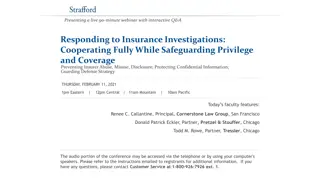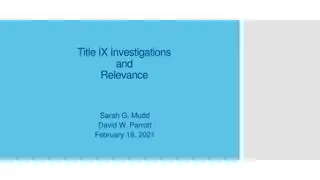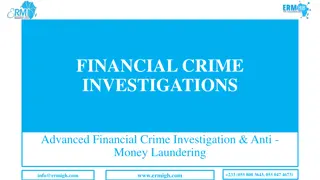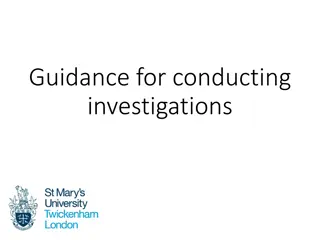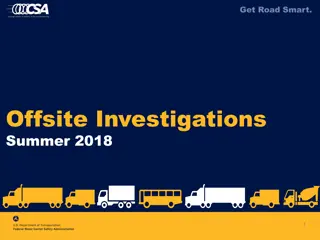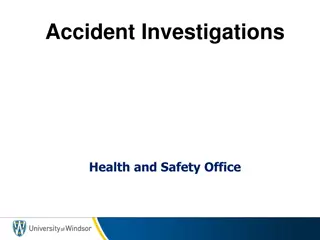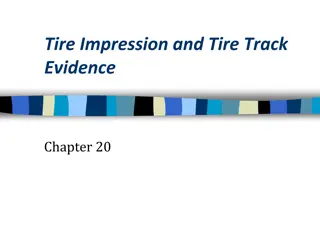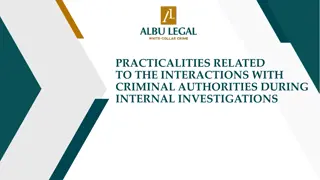Understanding Evidence in Investigations
Learn about the principles and types of evidence in investigations, including inculpatory and exculpatory evidence, physical, documentary, demonstrative, and verbal evidence. Explore sources of evidence and the significance of collecting relevant information to ensure a fair investigative process.
Download Presentation

Please find below an Image/Link to download the presentation.
The content on the website is provided AS IS for your information and personal use only. It may not be sold, licensed, or shared on other websites without obtaining consent from the author. Download presentation by click this link. If you encounter any issues during the download, it is possible that the publisher has removed the file from their server.
E N D
Presentation Transcript
Introduction to Evidence By Jennifer Glad, Associate Legal Counsel
General Evidence Principles of an Investigation It is the University s responsibility to conduct the investigation, identify and collect relevant inculpatory and exculpatory evidence, and interview witnesses Parties must have an equal opportunity to provide evidence (documents, testimony, etc.) and identify witnesses Parties must have an equal opportunity to review and comment on directly related evidence The goal of an investigation is evidence-gathering and ensuring an equitable process, not proving guilt or responsibility of the respondent
What is Inculpatory Evidence? Evidence tending to support the proposition that the respondent engaged in the conduct alleged. Examples may include: Surveillance or video footage showing a sexual assault A text message from the respondent stating: I m sorry, I should have stopped when you said no.
What is Exculpatory Evidence? Evidence tending to support the proposition that the respondent did not engage in the conduct alleged. Examples may include: A text message from the complainant to a friend saying: I said yes, but now I feel like he just used me.
Types of Evidence Physical Evidence Documentary Evidence Demonstrative Evidence Verbal Evidence Witness statements SANE kits Other physical objects Emails Snapchats Text messages Social media postings Student records, medical records, etc. Police reports Diary or journal Photos of injuries or locations of incidents Videos Security footage of an incident Timeline of events X-rays Maps or diagrams
Sources of Evidence Signed statements or interviews from the parties and witnesses Emails, text messages and other communications Social media posts Drawings or diagrams of an incident created after the fact Photographs or video recordings (security footage, phones, etc.) Medical records Student records Personnel files Documents that create a timeline of events (e.g., photos with timestamps, key card swipes, receipts, social media posts, etc.) Maps to reference distances Relevant notes, timecards, logs, expense reports, calendars, diaries or journals, etc. Registrar s Office, student conduct records, Office of Disability Services, class attendance records, HR records, ADA coordinator, etc.
Potential Evidentiary Exclusions Rape Shield Privacy restrictions (FERPA, personnel files, etc.) Medical, psychological, or similar records Information or evidence protected by a legally recognized privilege unless waived
Rape Shield All questions and evidence of a complainant s sexual predisposition are irrelevant, with no exceptions Questions and evidence about a complainant s prior sexual behavior are irrelevant, unless: The questions or evidence are offered to prove someone other than the respondent committed the conduct alleged; or The questions and evidence concern specific incidents of the complainant s prior sexual behavior with the respondent and are offered to prove consent
What is Relevant Evidence? Evidence is relevant if: It has any tendency to make a fact or allegation more or less probable than it would be without the evidence; and It is of consequence in determining the claim or allegation
Dangers of Irrelevant Evidence Wastes the time of the investigator, parties, and witnesses 1 May result in actual or perceived bias 2 May result in determinations based on improper considerations 3 May result in faulty or indefensible findings 4 May deny a party their rights to a fair determination 5
How to Evaluate Relevancy? 1. Review the evidence being offered (email, text messages, social media, etc.) 2. Consider the allegations of the complaint 3. Ask yourself if the evidence offered has the potential to prove/explain or disprove an allegation or claim
Evidence Review in Title IX Investigations Complainants and Respondents are entitled to review and respond to all evidence directly related to the complaint. This is broader than just relevant evidence and includes: Evidence directly related to the allegations in the complaint, Relevant evidence, and Evidence of potential bias or other considerations relevant to the allegations
What Evidence Goes in the Report? Investigators must summarize the relevant evidence in the investigation report. That evidence should include: Determinations based on logic and common sense Probative facts (e.g., tends to prove but not necessarily dispositive) Material facts (e.g., necessary to decide an issue in the case)
Burden of Proof/Standard of Evidence Clear and Convincing Insufficient Evidence Preponderance of the Evidence/More Likely Than Not No Evidence Beyond a Reasonable Doubt






